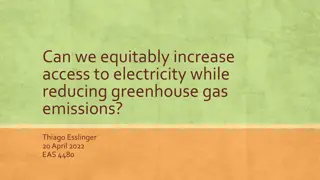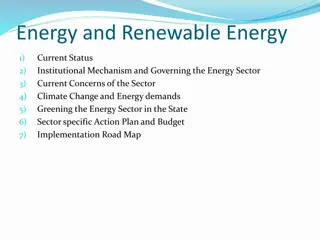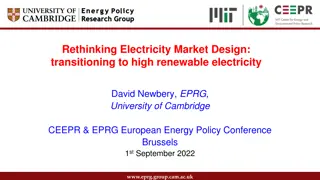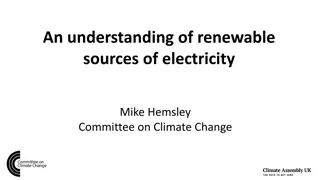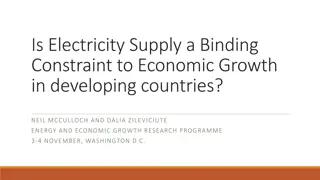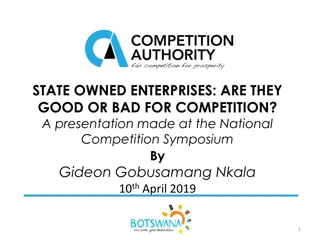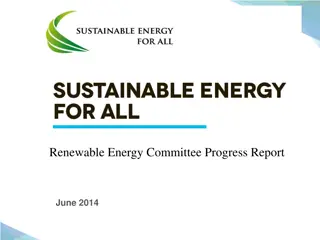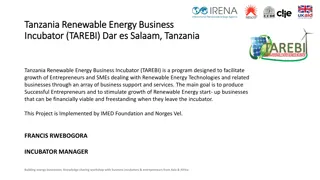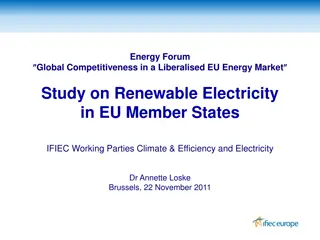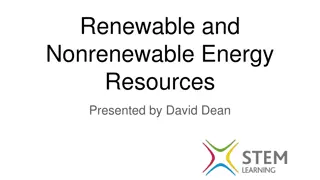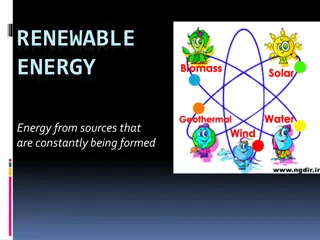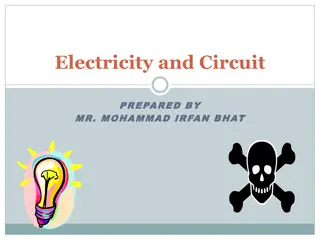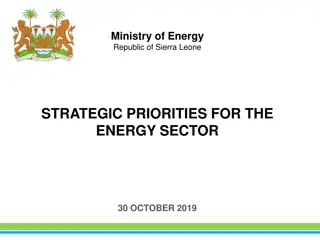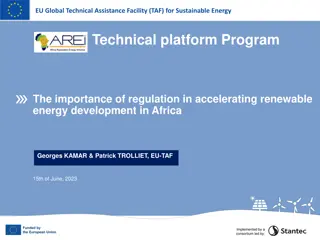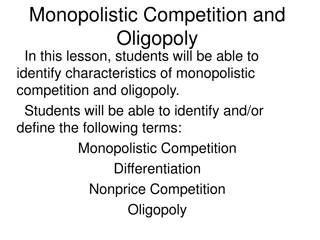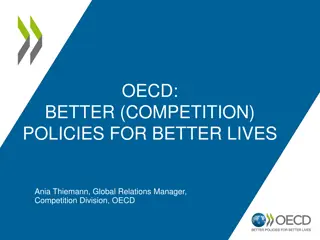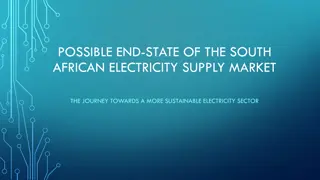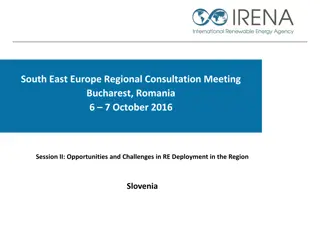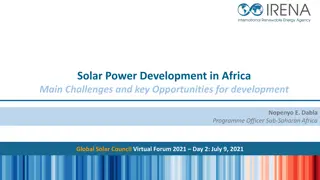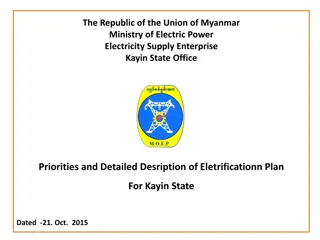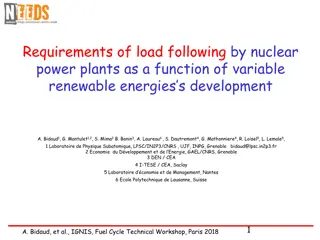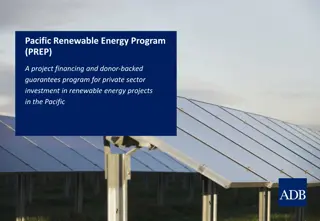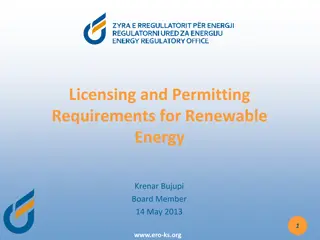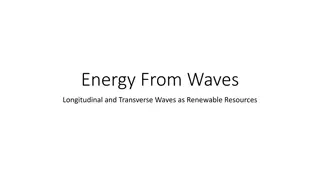Competition Challenges in 100% Renewable Electricity Supply
The Issues Paper identifies potential competition issues as the electricity system transitions to 100% renewable supply. There is concern about market power concentration and volatility under 100%RE. The analysis indicates that larger flexible generators may have increased means and incentives to raise price volatility. Various measures to tackle competition concerns are discussed, emphasizing the importance of proactive policy actions and structural changes.
Download Presentation

Please find below an Image/Link to download the presentation.
The content on the website is provided AS IS for your information and personal use only. It may not be sold, licensed, or shared on other websites without obtaining consent from the author. Download presentation by click this link. If you encounter any issues during the download, it is possible that the publisher has removed the file from their server.
E N D
Presentation Transcript
100% renewable electricity supply competition issues Material for MDAG meeting 24 August 2022 1
Executive summary The Issues Paper found that competition for medium/longer term flexibility services (e.g. wind firming ) may thin as the system shifts to 100% renewable electricity supply (100%RE). This is because ownership of flexible supply resource may become more concentrated, particular in the major hydro schemes. Secretariat work in recent months has explored the competition issues under 100%RE in more detail. This has included discussions with international competition experts and the Australian Energy Market Commission. These discussions highlight the importance of the shape of spot prices noting that competition in contracts and new investment markets may be impeded if some participant(s) can exercise market power to substantially alter shape of spot prices i.e. increase the volatility of volatility This slide deck summarises the draft results of quantitative analysis used to explore : Whether flexible generators will have greater/less means to exercise market power under 100%RE Whether flexible generators will have greater/less incentive to exercise market power under 100%RE Analysis focuses on the 2035 timeframe and assumes all fossil fuelled plant is retired, there is 600MW of green peaker capacity spread between CEN, GEN and other participant(s), and other generation (hydro, wind, geothermal) remains under current ownership. Analysis focuses on the extent to which larger flexible generators would have the means and incentives to raise volatility of volatility to delay new generation entry and lift average spot prices Key findings from analysis are: Larger flexible generators may have greater means to raise volatility of volatility under 100%RE Larger flexible generators would likely have stronger incentives to raise volatility under 100%RE 2
Executive summary (contd) The slide deck also explores options to address competition concerns. These options may be applied ex ante or ex post and fall into two broad categories: Conduct measures these seek to deter or mitigate the exercise of market power. They can be modified over time, but require active and ongoing monitoring and enforcement. Structural measures these seek to reduce market power at its source. They require little monitoring once in place, but need careful consideration beforehand to avoid unintended consequences. Slides 23-29 discuss a broad range of options with a high level of assessment of pros and cons of each option. Proposed competition measures Based on current information, propose that policy attention should focus on: Extending trading conduct rules to contract market transactions Improving transparency of contract prices (especially shaped products) Flexibility access code Market making in caps However, conduct measures may ultimately not provide sufficient competition. For this reason, structural measures may be required at a later point. If that is the case, the conduct measures above should provide a strong information base for designing and applying future structural measures. Proposed timetable Propose that work on pro-competition conduct measures would commence immediately upon conclusion of 100%RE project given that transition is already underway, and confidence in competition is a foundational element of a 100%RE system. 3
What this pack covers 1. What competition concerns might arise with 100% renewables 2. Approach to gauging significance of potential concerns 3. Options to address potential concerns 4
What competition concern might arise with 100% renewables? 5
Potential areas of competition concern Electricity systems need resources to provide flexibility services i.e. energy sources/sinks that can offset fluctuations in uncontrollable supply or demand At present, flexibility services are largely provided by thermals, controllable hydro, demand response Looking ahead: Batteries expected to grow in number and scale Fossil-fuelled plant expected to progressively retire Uncontrollable generation (e.g. wind and solar) expected to increase All else being equal, these factors are expected to: Maintain/strengthen competition for short term flexibility services (< few days) Reduce competition for medium/longer term flexibility services (> few days) 6
Approach used to gauge significance of potential concerns 7
Analytical framework Engaged with Prof George Yarrow and Dr Chris Decker (UK-based competition experts) to discuss competition issues that might arise under 100%RE Engaged with AEMC to obtain Australian perspective on competition issues in NEM as thermals wind down Key points to emerge from discussions: Analysis of competition for flexible resources is complex but the shape of spot prices is likely to be a key issue Competition in contracts and new investment markets may be impeded if some participant(s) can exercise market power to substantially alter shape of spot prices i.e. increase the volatility of volatility This type of issue was a concern in UK in early 1990s when two large players were regarded as having significant market power Market power can be regarded as significant if the economic cost of the harm exceeds economic cost of the remedy Electricity markets are unusual a lot of harm can be done in a short period Key issues to consider are whether participants will have means and incentive to exercise market power and how this changes relative to historical position Potential solutions to competition problems typically fall into a 2x2 matrix solutions can be structural or conduct-based, and can be applied ex ante or ex post 8
Analytical tools Quantitative primary tool is model that was used for Issues Paper. This model has: Key inputs projected demand, supply options (gen and batteries) and costs, various offer strategies for hydros (water values), system investment states (balanced, long, short generation), demand response etc. Key outputs - hourly data on prices, demand, generation for 86 weather years for a given set of input assumptions Participants modelling makes assumptions about future make-up of participants generation portfolios, focussing on those participants with sizeable flexible hydro bases. We use company names to identify these parties, but important to emphasise the modelled portfolios reflect assumptions about their resource bases in 2035. Actual plans/outcomes for these companies may differ from assumed portfolios. Period of interest model can examine the 2035 and 2050 reference years. We focus on 2035 for competition work as 2050 is much further into the future. Note that 2035 model year assumes retirement of Tiwai smelter so its system condition may arise before 2035 if Tiwai remains as a large inflexible demand. System resources - scenarios assume 100% renewable generation unless otherwise stated. General caveat modelling is used to assess broad likelihood and scale of potential issues using historical position as a comparative reference. Difficult to make definitive determinations, given uncertainties when looking into the future and level of precision available in modelling. 9
Assumed portfolios in 2035 Generation Load/Swaps Caps Contact 2035 Clutha scheme Geothermals 200 MW green peakers Mass Market Commercial N.A. Genesis 2035 Tekapo, Tongariro and Waikaremoana schemes Waipipi output 45 MW green peakers Mass Market Commercial N.A. Mercury 2035 Waikato scheme Geothermals Turitea, Tararua and Mahinerangi wind farms Mass Market Flats Various see later Meridian 2035 Waitaki scheme Mill Creek, Te Apiti, Te Uku, Westwind, White Hill wind farms Mass Market Flats Commercial Various see later Independent Wind 2035 500 MW of wind in upper North Island Sales to achieve min risk level Various see later Independent Solar 2035 500 MW of solar in upper North Island Sales to achieve min risk level Various see later Note, the volume of retail load/swaps sold by each participant is set to achieve a roughly minimum risk level in the Base Price Duration Curve (PDC) Scenario. For other PDC scenarios (see later slides for info) the total volume of retail load/swap sales is adjusted to identify the new minimum risk position noting the ratio of retail sales to swaps is held constant across scenarios. 10
Core competition question Question: Will some generator(s) have the means and incentive to increase volatility of volatility under 100% RE? Answer: Analysis indicates larger flexible generators may have greater means to raise volatility of volatility, and would likely have stronger incentives to do so than in the past. Underlying propositions that have been analysed Observation and reasoning Proposition 1 Would some generators have materially greater scope to the raise volatility of volatility under 100% renewable supply? Answer: potentially yes. Flexible generation is likely to be much more concentrated under 100%RE in the hands of participants with larger hydro schemes. Spot price volatility is sensitive to hydro offer behaviour, and a range of possible offer strategies appear feasible. The key uncertainty in relation to market power is whether volatility of volatility could be raised by a single generator, or whether some degree of cooperation would be required. It has not be been possible to test this point with the modelling. Proposition 2 Would generators with significant flexible resources face much direct cost/disruption from raising volatility of volatility? Answer: likely yes. Generators with the larger flexible hydro bases appear to be relatively well insulated from changes in volatility of volatility. This is based on analysis which indicates that their expected earnings, level of cashflow at risk and preferred contracting levels are similar, irrespective of whether volatility is relatively high or relatively low. Proposition 3 Would potential new entrant intermittent generators without access to flexibility services be deterred if there is significant volatility of volatility. Answer: likely yes. Independent wind or solar generators would not be well insulated against changes in volatility of volatility. This is based on analysis which examines the expected earnings, level of cashflow at risk and preferred contracting levels for intermittent generators under different PDC scenarios. The analysis assumes these generators sell baseload swaps to minimise the variability of their gross margins, relative to mean expected levels. Despite this action, there is substantial variation in earnings volatility [and preferred contract levels]. Proposition 4 Would generators with significant flexible resources face a likely material gain if new entry is deterred (i.e. delayed). Answer: likely yes. If new entry is deterred on a sustained basis, this would be expected to raise average prices and appreciably increase gross margins for incumbent suppliers. Furthermore, while there is a possibility that an increase in volatility of volatility may increase forward contracting by wholesale purchases and encourage (i.e. bring forward) new entry, the consequent reduction in average prices is likely to be smaller than the price increase if entry is delayed by an equivalent amount i.e. early/delayed entry have asymmetric price effects for any given MW volume. More detail on the reasoning referred to in the table is set out in the following slides 11
Proposition 1 Would some generators have greater scope to raise volatility of volatility under 100%RE? Generation distribution curves (normalised to 100%) Analysis was undertaken to see how market concentration among providers of medium-term flexibility could change under 100%RE since this affects the scope to exercise market power. 5%ile Note that flexibility is multi-dimensional, and there is no comprehensive and accepted way to define and measure flexibility. Flexible MW range for Manapouri output For the purposes of this analysis, consider plant-types that can control their output over periods longer than 24 hours since these plant types have greatest ability to alter shape of spot prices. This means the analysis focusses on thermal and hydro capacity (batteries run time is too short, wind and solar are intermittent and geothermal is typically inflexible). Full nameplate capacity of thermal plant was treated as flexible noting total nameplate capacity is lower under 100%RE as only green peakers are assumed to remain. 95%ile Unlike thermal plant, some hydro may not be readily turned off or run at full output hence the nameplate MW would overstate flexibility range. Instead, the coincident half-hourly output of each major hydro scheme was examined to identify the proportion that appears to be flexible. The difference between the observed P5 and P95 MW values was treated as the flexible tranche of hydro capacity. Flexible Hydro MW as a percentage of Nameplate Entity Note the above analysis does not account for all factors that can constrain extended energy production such as thermal fuel availability or droughts. However, it should provide an approximation of the MW capacity that can be controlled at relatively short notice and over periods of 24 hours or more. Contact Mercury Meridian Genesis 62% 63% 61% 81% 12
Proposition 1 Would some generators have greater scope to raise volatility of volatility under 100%RE? Ownership of flexible hydro and thermal capacity - current Charts show ownership shares for flexible hydro and thermal capacity at present, and under 2035 scenario (using flex definition in previous slide). 4% 24% Capacity share data was used to calculate Herfindahl Hirshmann Index (HHI) values this is a measure of market concentration commonly used by competition authorities Below 1500 is typically regarded as competitive 1500-2500 moderately concentrated 2500+ highly concentrated 30% HHI=2482 14% 28% Contact Mercury Meridian Genesis Other Ownership of flexible hydro and thermal capacity 2035 100%RE scenario Key points to note when comparing current and 100%RE results HHI rises but increase is relatively modest. However, HHI indicates relatively concentrated market in current state Flexible capacity share for largest single party rises from 30% to 40% Overall flexible hydro/thermal MW capacity shrinks significantly (4,984 MW at present vs 3,563 MW in 2035) all other things being equal. 5% 19% 17% HHI=2617 19% 40% Contact Mercury Meridian Genesis Other 13
Proposition 1 Would some generators have greater scope to raise volatility of volatility under 100%RE? $500 2035 $450 Used model to test sensitivity of PDCs to hydro offer behaviour In particular, explore whether PDC could change while still maintaining new entry equilibrium (i.e. new investment forces alone would not push the overall market to a particular PDC outcome that would be stable over time) Analysis indicates a range of PDCs are feasible that would satisfy new entry equilibrium requirement (at least within modelling error) We refer to these scenarios as: Base central reference case Less bang-bang lower volatility than base More bang-bang higher volatility than base Analysis indicates appreciable scope for PDC to vary in the mid and upper ranges in response to hydro offer behaviour However, modelling unable to discern how sensitive PDCs would be to offer behaviour of individual participants $400 $350 $300 0 to 100% of time $250 $200 $150 $100 $50 $0 0% 20% 40% 60% 80% 100% $2,000 2035 $1,800 $1,600 $1,400 $1,200 0 to 10% of time $1,000 $800 $600 $400 $200 $0 0% 2% 4% 6% 8% 10% 14
Proposition 2 Would generators with significant flexibility face much direct cost/disruption from raising volatility of volatility? Gross margins for larger gencos do not vary markedly across the different PDC scenarios Gross margins for larger generators are similar in the base and less bang bang scenarios Gross margins for larger generators under more bang bang PDC are higher than base PDC (especially for MRC and MRD) but not markedly so furthermore the analysis assumes all gencos adopt similar offer strategies. If CEN and GEN were more passive in their offers, the overall gain for MRC and MRD from more bang bang PDC would be smaller as it would be shared across generators. 15.0% Mean gross margin in each PDC scenario relative to mean gross margin in base PDC scenario 15.0% Min risk gross margin in each PDC scenario relative to min risk gross margin in base PDC scenario 12.5% 12.5% % of Generator's MinRisk GM for PDC Scenario % of Generator's Mean GM for PDC Scenario 10.0% 10.0% 7.5% 7.5% 5.0% 5.0% 2.5% 2.5% 0.0% 0.0% -2.5% -2.5% -5.0% -5.0% 2035 -7.5% -7.5% 2035 -10.0% -10.0% CEN GEN MRC MRD CEN GEN MRC MRD 15
Proposition 2 Would generators with significant flexibility face much direct cost/disruption from raising volatility of volatility? Contracting trade-offs for larger gencos appear relatively similar across PDC scenarios Risk curves below show how much gross margin (at 5%ile level) changes if contract level is not at optimal least risk position (i.e. where 5%ile gross margin is maximised). Peakier shapes indicate a greater loss of earnings for being away from optimal position. Flat shapes indicate wider latitude for contracting (i.e. small expected sacrifice from being away from optimal position. Shapes are similar for each PDC (but vary across parties) Vertical arrows between peaks of curves indicate how much min risk gross margin varies across PDCs. Differences are small in all cases (~4% or less) Horizontal arrows between peaks of curves shows how much a participant would need to alter its contract level (as % of mean generation output) to minimise its risk position depending on each PDC scenario. Differences are relatively small (<10%) in all cases. 110.0% 110.0% MRD MRC 107.5% 107.5% 105.0% 105.0% 103.7% Vertical axis shows the minimum expected gross margin (at 5%ile level) for each genco, expressed as % of gross earnings expected for the minimum risk contracting level in the base PDC scenario 103.2% 102.5% 102.5% 100.5% ~3% ~4% 100% 100.0% 100.0% 99.8% 100% 97.5% 97.5% 95.0% 95.0% ~5% points 92.5% 92.5% ~6% points 90.0% 90.0% 80% 85% 90% 95% 100% 105% 80% 85% 90% 95% 100% 105% 110.0% 110.0% GEN CEN 107.5% 107.5% 105.0% 105.0% 103.2% 101.3% 102.5% 102.5% 100% 100.1% ~3% ~1% 100.0% 100.0% 100% 99.4% 97.5% 97.5% 95.0% 95.0% 92.5% ~2% points 92.5% ~9% points 90.0% 90.0% 80% 85% 90% 95% 100% 105% 110% 55% 60% 65% 70% 75% 80% Percentage Generation (GWh) Contracted / Committed Percentage Generation (GWh) Contracted / Committed 16
Proposition 3 Would potential new entrant intermittent generators be deterred if there is significant volatility of volatility? Dots indicate expected risk/reward outcome for each participant if they sell sufficient contracts to minimise risk at 5% level. Wind and solar developers assumed to sell baseload swaps. See earlier slide for portfolio assumptions for other participants. Contracts assumed to trade at zero premium/discount to expected value. 110% 110% Mean gross margin relative to base PDC PDC: Less BB PDC: Base BB 106% 106% 102% 102% Simulated historical 98% 98% 94% 94% Cashflow at risk for independent solar and wind generators increases in 2035, especially wind, and is higher than for flexible parties. Cashflow at risk for independent solar and wind generators increases in 2035, especially wind, and is higher than for flexible parties. Cashflow at risk for major hydro gencos shows little % change in 2035 Cashflow at risk for major hydro gencos shows little % change in 2035 90% 90% 110% 110% Mean gross margin relative to base PDC 106% 106% 102% 102% 2035 98% 98% 94% 94% 90% 90% Cashflow at risk (expected reduction in mean gross margin at 5% risk level) Cashflow at risk (expected reduction in mean gross margin at 5% risk level) Simulated historical = based on existing portfolios with fossil-fuelled thermals, but with PDCs that reflect new entry equilibria. 2035 assumes all fossil-fuelled thermal is retired as per earlier slide. 17
Proposition 3 Would potential new entrant intermittent generators be deterred if there is significant volatility of volatility? PDC: Base BB PDC: More BB 110% 110% Mean gross margin relative to base PDC 106% 106% 102% 102% Simulated historical 98% 98% Cashflow at risk for independent solar and wind generators increases in 2035, especially wind, and is higher than for flexible parties. 94% 94% Cashflow at risk for independent solar and wind generators increases in 2035, especially wind, and is higher than for flexible parties. Cashflow at risk for major hydro gencos shows little % change in 2035 Cashflow at risk for major hydro gencos shows little % change in 2035 90% 90% 110% Mean gross margin relative to base PDC 110% 106% 106% 102% 102% 2035 98% 98% 94% 94% 90% 90% Cashflow at risk (expected reduction in mean gross margin at 5% risk level) Cashflow at risk (expected reduction in mean gross margin at 5% risk level) Simulated historical = based on existing portfolios with fossil-fuelled thermals, but with PDCs that reflect new entry equilibria. 2035 assumes all fossil-fuelled thermal is retired as per earlier slide. 18
Proposition 3 Would potential new entrant intermittent generators be deterred if there is significant volatility of volatility? Contracting trade-offs for independent intermittent generators are more sensitive to PDC scenarios Vertical arrows between peaks of curves indicate how much min risk gross margin varies across PDCs. Differences are ~10%-13% (cf. 4% of less for larger generators) Horizontal arrows between peaks of curves shows how much a participant would need to alter its contract level (as % of mean generation output) to minimise its risk position depending on each PDC scenario. Differences are relatively small (<10%) in all cases. In addition, as shown on previous slide, independent intermittent generators (especially wind) face significantly higher cashflow at risk than integrated parties. Wind Solar 110.0% 110.0% Vertical axis shows the minimum expected gross margin (at 5%ile level) for each genco, expressed as % of gross earnings expected for the minimum risk contracting level in the base PDC scenario 105.0% 105.0% 102.5% 102.2% 100.0% 100.0% 100% 100% ~10% ~13% 95.0% 95.0% 92.6% 89.4% 90.0% 90.0% 85.0% 85.0% ~5% points ~5% points 80.0% 80.0% 40% 43% 45% 48% 50% 53% 55% 60% 62% 64% 66% 68% 70% 72% 74% Percentage Generation (GWh) Contracted / Committed Percentage Generation (GWh) Contracted / Committed 19
Proposition 4 Would generators with significant flexible resources face likely material gain if new entry is deterred? $500 2035 $450 $400 Used model to test sensitivity of PDCs to delayed or early entry by new generation by wind and solar (predominant sources of supply at the margin) $350 $300 0 to 100% of time $250 $200 New entry deterred scenario this models a PDC that results if new entry is delayed $150 $100 $50 The new entry deterred scenario can be interpreted as a new entry equilibrium if wind/solar investors required a higher return to offset perceived risks relating to volatility of volatility $0 0% 20% 40% 60% 80% 2035 100% $2,500 $2,000 Also compiled new entry encouraged scenario this model a case which is the mirror image of the delay scenario. $1,500 0 to 10% of time $1,000 Such a scenario might occur if demand side parties lifted their contracting levels in response to higher volatility of volatility, and hence stimulated earlier entry. $500 $0 0% 2% 4% 6% 8% 10% 20
Proposition 4 Would generators with significant flexibility face likely material gain if new entry is deterred Major genco s accrue appreciable benefit relative to base case if new entry is deterred, and lose if entry is encouraged but gain is asymmetric to loss for MRD and MRC Mean gross margin in each PDC scenario relative to mean gross margin in base PDC scenario Min risk gross margin in each PDC scenario relative to min risk gross margin in base PDC scenario Chart Title Chart Title 15.0% 15.0% % of Generator's Mean GM for PDC Scenario % of Generator's MinRisk GM for PDC Scenario 12.5% 12.5% Genco s benefit if new entry deterred (yellow) 10.0% 10.0% 7.5% 7.5% 5.0% 5.0% 2.5% 2.5% 0.0% 0.0% -2.5% -2.5% -5.0% -5.0% Genco s have similar or lower earnings (blue) if premature entry occurs loss is not symmetric to gain from deterred entry (yellow) 2035 2035 -7.5% -7.5% -10.0% -10.0% CEN GEN MRC MRD CEN GEN MRC MRD 21
What are the options to address potential concerns? 22
High level options Conduct measures seek to deter or mitigate the exercise of market power. They can be modified over time, but require active and ongoing monitoring and enforcement. Structural measures seek to reduce market power at source. They require little monitoring once in place, but need careful consideration beforehand to avoid unintended consequences. Ex ante Ex post Increase contract market transparency Introduce flexibility service access code Introduce market-making in price caps or similar products Require parties with substantial flexibility to maintain minimum contract levels/offers Apply spot market price caps Apply offer price caps Apply contract price caps Extend trading conduct rules to contract market Market conduct Provide for disaggregation of major flexibility sources (via contracts or physically) if pre- defined market abuse conditions are triggered Require participants with substantial market power to undertake generation development in ring-fenced entities Extend virtual asset swaps (expiring 2023) Reduce market concentration via virtual break-up of major flexibility sources Reduce market concentration via physical break-up of major flexibility sources Facilitate entry of additional flexibility resources Market structure 23
High-level conduct options Option and rationale Would it restrain market power? How significant are the risks and why? 1 Extend trading conduct rules to hedge market the current rules require suppliers to makes offers that are consistent with those expected from a party that does not have significant market power. The rules cover the wholesale market but exclude the hedge (contract) market. Yes potentially* - The rules would need to be modified to cover hedge transactions, but the underlying economic and legal framework would be the same. This measure would probably require increased transparency (see below) in relation to contract offers and executed deals to be effective. Unclear - difficult to assess risks as the rules for the spot market are relatively new. 2 Increase contract price transparency parties entering into wholesale contracts are required to disclose certain elements onto a platform, and this platform publishes the summary information in anonymized form. The extent of disclosure to (and from) the platform could be enhanced. Areas to consider include: 1. More information on prices for non-baseload (shaped) products 2. Information on prices for contract modifications (e.g. currently excluded) 3. Information on prices of executable offers/bids that were declined. Yes potentially* - increased transparency by itself is unlikely to significantly restrain market power. However, it could assist other measures to be effective. It would also potentially improve the effectiveness of the Commerce Act. In particular, the new test in s.36 prohibits conduct which has purpose, or has or is likely to have the effect, of substantially lessening competition in a market or related market. How generators with flexibility respond to requests for firming contracts appears to have direct relevance to competition in the new generation market. Low as measure would not compel any specific action other than information provision. Remaining risks appear to be: Whether transparency might impede competition by improving suppliers knowledge about competitor actions Whether parties might adopt less efficient practices to avoid/delay contract disclosure 3 Introduce flexibility product access code - generators with substantial market power would be required to follow defined processes when dealing with requests for flexibility contracts. This could include: 1. Requirement on relevant parties to specify information they need from parties seeking flexibility contracts. 2. Requirement on relevant generators to respond to requests within defined timeframes and in writing, and with reasons if a request is declined. 3. Record keeping obligations on relevant parties. Yes potentially* - option conceptually similar to the proposed access code for supermarket wholesale services. It is intended to make it easier for participants and regulators to detect any abuse of market power in flexibility contracts market. For example, it should provide information to better identify whether contract capacity is being withheld or priced in an anti-competitive manner. Enforcement would rely on Code (trading conduct see 1) and/or Commerce Act provisions. Low would impose additional transaction costs otherwise appears to be relatively low risk. 4 Market makingin caps market making would be introduced for cap contracts (or similar shaped products such as capped swaps). Obligations to market-make could be applied to generators with substantial market power, and/or costs of commercial market making could be recovered (wholly or mainly) from these parties.. Yes potentially* - the presence of forward prices for shaped products should assist independent retailers, demand response providers and parties with investment and planning decisions, such as investment in intermittent generation (see later charts). An obligation on generators with substantial market power to market-make or bear the cost of commercial services should reduce the incentive on these generators to increase the volatility of volatility. Unclear - need to consider the practicality of market-making in shaped products, such as margin requirements for exchange traded caps. * Assessment of effectiveness assumes other mutually reinforcing measures would be applied. Effectiveness of measure on stand-alone basis would be lower than as part of package. 24
How risk/rewards change for solar and wind if they can purchase cap contracts (less bang-bang and base PDC scenarios) PDC: Less BB PDC: Base 108% 108% Mean gross margin relative to base PDC 103% 103% No Caps 98% 98% 93% 93% Cashflow at risk reduces if solar/wind can purchase cap contracts Cashflow at risk reduces if solar/wind can purchase cap contracts Mean gross margin relative to base PDC 108% 108% 103% 103% $500 Caps 98% 98% 93% 93% 108% 108% Mean gross margin relative to base PDC 103% 103% $300 Caps 98% 98% 93% 93% Cashflow at risk (expected reduction in mean gross margin at 5% risk level) Cashflow at risk (expected reduction in mean gross margin at 5% risk level) 25
How risk/rewards change for solar and wind if they can purchase cap contracts (base and more bang-bang PDC scenarios) PDC: More BB PDC: Base 108% 108% 103% 103% No Caps Cashflow at risk reduces if solar/wind can purchase cap contracts 98% 98% 93% 93% 108% 108% 103% 103% Cashflow at risk reduces if solar/wind can purchase cap contracts $500 Caps 98% 98% 93% 93% 108% 108% 103% 103% $300 Caps 98% 98% 93% 93% Portfolio Caps Flats (MW) Caps (MW) The flats sold and caps purchased are for the minimum CFaR position in each case. These flats/caps volumes differ between the $500 and $300 Caps, hence results reflect changes in swap sale volumes and types of caps being purchased. $500 $300 225 75 200 50 Wind $500 $300 200 100 175 50 26 Solar
How risk/rewards change for participants depending on availability of caps at different prices PDC: Base 2035 108% MRC and MRD are assumed to have sold ~250 MW of caps as part of their contract books. Results show minimum risk position for each participant (i.e. where aggregate sale volume of retail, swaps, caps) has lowest cashflow at risk at 5%ile level. 103% No Caps 98% For MRC and MRD, selling caps tends to increase cashflow at risk but effects are relatively modest in scenario 93% 108% 103% $500 Caps 98% Cashflow at risk reduces if solar/wind can purchase cap contracts 93% 108% 103% $300 Caps 98% 93% 108% Results for $200 caps assume some running of gas-fired peakers using $12/GJ gas and incurring carbon charge of $140/t i.e. not 100% renewable unlike all other scenarios. 103% $200 Caps 98% Y-axes: Mean gross margin relative to base PDC 93% X-axes: Cashflow at risk (expected reduction in mean gross margin at 5% risk level) 27
High-level conductoptions (contd) Option and rationale Would it restrain market power? How significant are the risks and why? 5 Minimum level of forward contracting or offers - generators with substantial market power would be required to offer additional contracts for sale if actual contract sales were below a minimum level. Seems unlikely forward contracting obligations can reduce incentives to exercise market power in spot market. However, there would be no mechanism to ensure that contracts being offered are available on reasonable terms. Possibly significant - contracting obligation could unintentionally undermine investment incentives for applicable participants. 6 Spot market price cap a formal price cap would apply in the spot market. Seems unlikely the principal concern in this instance relates to the shape of the price duration curve, and the scope for generators with significant hydro flexibility to alter that structure in a way that increases the volatility of volatility. A spot price cap is unlikely to substantially reduce that scope. Possibly significant - depending on its level, a spot price cap could suppress incentives for efficient demand response, use of storage, forward contracting, and investment. 7 Selective offer price cap generators with substantial market power would be subject to a cap on their offer prices. This approach is used in parts of the US. It means that high spot prices can only emerge if a smaller player (generation, battery or demand response) offers its capacity at a high price. Unclear - relies on assumption that there will be smaller parties active in the spot market who do not have substantial market power. That may not be realistic given the relatively small size of the NZ market, especially in periods/regions where supply is tight on a transitory basis. Possibly significant - short-term market power changes every hour. Mechanism may be difficult to properly implement in practice. 8 Contract price cap generators with substantial market power would be subject to a cap of prices charged for their contracts. Unclear relevant generators would be deterred from market abuse in spot market because wholesale buyers could purchase contracts to reduce their spot exposure. Possibly significant - difficult to set correct price, especially for shaped products. Setting cap too low would suppress incentives to invest in DR, storage and flex gen 28
High-level structural options Option and rationale Would it restrain market power? How significant are the risks and why? 9 Ringfencing - generators with substantial market power would be required to undertake generation developments in a ring-fenced entity. Unclear the treatment of ringfenced development affiliates could provide a reference point for assessing major generators contracting interactions with independent generation/developers. However, there may not be any useful transfer price data produced by a ringfence. Possibly significant may undermine incentive for major generators to develop new generation. 10 Extend virtual asset swap provisions Meridian has entered into baseload swaps between the islands with Genesis and Mercury. Public sources indicate these will expire in 2023. Unlikely because these are locational baseload swaps, they appear unlikely to have any material effect on incentives to alter the shape of spot prices. Unclear hard to assess because there is almost no information available on the effects of the existing swaps. 11 Virtual break-up some capacity of dominant generators would be reassigned via long-term contracts. Ownership and generation dispatch rights would remain unchanged. The capacity transfer should reduce the incentives on dominant generators to exercise market power. Yesin principle if sufficient capacity is transferred and held among multiple parties. Potentially significant implementation could take some time including a possible transition. Investment incentives may be reduced in the meantime. 12 Physical break-up some capacity of dominant generators would be reassigned via sale (including dispatch rights). Unclear there are limited options available unless disaggregation of stations on single river chains are considered. Unclear how much competition benefit would arise from physical break-up that avoided disaggregation of stations on single river chains. Likely significant ownership changes can be disruptive and any disaggregation of stations on single river chains may lead to coordination inefficiencies. 13 Centrally procure new flexible capacity new flexibility sources (storage, DR, or flex gen) could be procured or underwritten via central support mechanism such as long-term contracts with costs recovered via levy. Yesin principle if sufficient capacity is created and held among multiple parties. Potentially significant implementation would likely take some time. Investment incentives may be reduced in the meantime. 29
Overall assessment of options Expected competition benefits Preferred options Based on current information, propose that policy attention should focus on conduct measures in green box as they offer appreciable potential competition benefits but have significantly lower risk of unintended harm than options in quadrants II. & IV. 11.Virtual break-up II. I. 1.Extend conduct rules 2.Greater transparency 3.Flexibility access code 4.Market making in caps 13.Centrally procure new flexible capacity These conduct measures would need to be pursued together as they are mutually supporting. However, also need to recognise that conduct measures may ultimately not provide sufficient competition. For this reason, structural measures may be required at a later point. IV. III. 12.Physical break-up 9.Ring fencing for new development If that is the case, the conduct measures in quadrant I should provide a strong information base for designing and applying future structural measures. Proposed timetable 5.Minimum contract obligation 6.Spot market price or offer cap 7.Selective offer price caps 8.Contract price caps 10.Extend virtual asset swaps Risk of unintended harm or costs Propose that work on pro-competition measures in green box would commence immediately upon conclusion of 100%RE project. This is because: the transition to 100%RE is underway and there are strong indications that increased price volatility is already manifesting in the spot market while the competition modelling was for 2035 demand levels, it assumed the Tiwai smelter will close. If the smelter remains open, the modelled outcomes would come forward in time by around five years (i.e. to ~2030) it will take significant time to design and implement the proposed measures confidence in competition is a foundational must have element for a 100%RE system to provide reliable and affordable power. 30



